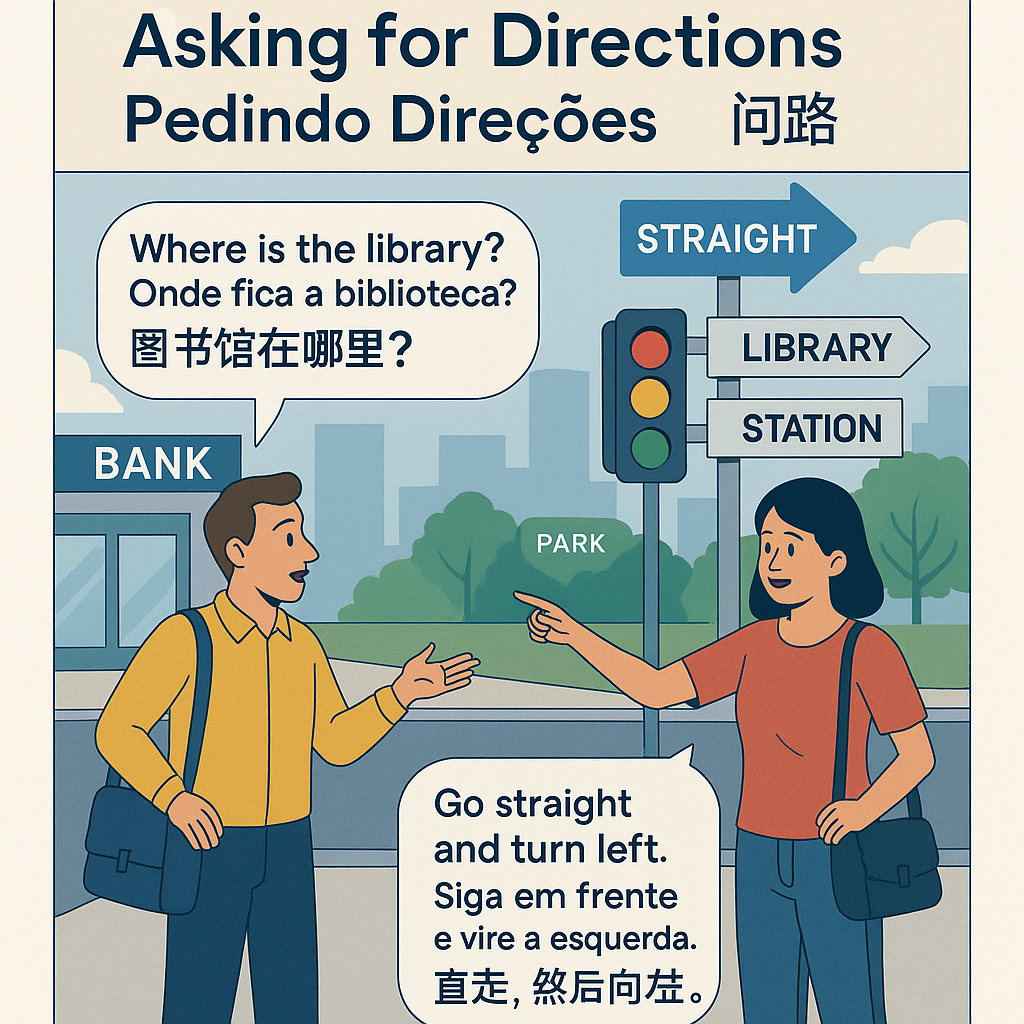🔤 Trilingual: English | 中文 (Mandarin) | Português
📘 Level: Beginner
🧭 Topic: How to ask for and give directions in real situations
🎯 Objective / Objetivo / 目标
By the end of this lesson, learners will:
✔️ Ask where places are and understand responses
✔️ Use location prepositions and landmarks
✔️ Use essential Mandarin and Portuguese expressions to ask and follow directions
✔️ Read and recognize basic signs or instructions
📖 1. English Explanation (Main Focus)
When traveling, especially in a new country or city, being able to ask for directions is one of the most useful skills. In English, direction-related expressions often include polite questions, landmarks, and prepositions of place.
🔑 Key Vocabulary:
| English | Pinyin | 中文 (Mandarin) | Português |
|---|---|---|---|
| Where is…? | zài nǎlǐ? | 在哪里? | Onde fica…? |
| Turn left | zuǒ zhuǎn | 左转 | Vire à esquerda |
| Turn right | yòu zhuǎn | 右转 | Vire à direita |
| Go straight | zhí zǒu | 直走 | Siga em frente |
| Traffic light | hónglǜdēng | 红绿灯 | Semáforo |
| Near / Close | fùjìn | 附近 | Perto |
| Far | hěn yuǎn | 很远 | Longe |
| Next to | pángbiān | 旁边 | Ao lado de |
| Across from | duìmiàn | 对面 | Em frente a |
🧠 2. Mandarin Grammar Tips
Sentence Pattern:
Place + 在 + 哪里?(Where is…?)
🔹 医院在哪里?Yīyuàn zài nǎlǐ? → Where is the hospital?
Giving Directions in Mandarin:
-
向左转 (xiàng zuǒ zhuǎn) – Turn left
-
一直走 (yī zhí zǒu) – Keep going straight
-
你会看到… (nǐ huì kàn dào…) – You will see…
🇵🇹 3. Explicação em Português
Saber pedir direções é essencial para qualquer pessoa que viaja. Em português, usamos perguntas simples e diretas como “Onde fica…?” e damos instruções com verbos no imperativo como “vire”, “siga”, “continue”.
Vocabulário útil:
| Português | Inglês | Chinês | Pinyin |
|---|---|---|---|
| Onde fica…? | Where is…? | 哪里 | nǎlǐ |
| Siga em frente | Go straight | 直走 | zhí zǒu |
| Vire à esquerda | Turn left | 左转 | zuǒ zhuǎn |
| Ao lado de | Next to | 旁边 | pángbiān |
| Em frente a | Across from | 对面 | duìmiàn |
| Muito longe | Very far | 很远 | hěn yuǎn |
| Próximo | Close | 附近 | fùjìn |
🗣️ 4. Dialogue | Diálogo | 对话练习
English
A: Excuse me, where is the train station?
B: Go straight and turn right at the traffic light. It’s next to the supermarket.
中文
A:请问,火车站在哪里?
B:一直走,在红绿灯那里右转。火车站在超市旁边。
Português
A: Com licença, onde fica a estação de trem?
B: Siga em frente e vire à direita no semáforo. Fica ao lado do supermercado.
✍️ 5. Practice Sentences
English:
-
Where is the nearest pharmacy?
-
Is the park far from here?
-
Turn left at the next corner.
中文:
-
最近的药店在哪里?(Zuì jìn de yàodiàn zài nǎlǐ?)
-
公园离这里远吗?(Gōngyuán lí zhèlǐ yuǎn ma?)
-
在下一个路口左转。(Zài xià yīgè lùkǒu zuǒ zhuǎn)
Português:
-
Onde fica a farmácia mais próxima?
-
O parque é longe daqui?
-
Vire à esquerda na próxima esquina.
📌 6. Cultural Note
🧭 In many Chinese cities, directions often include large landmarks like shopping malls, bridges, or banks. Instead of giving street names, locals usually say things like:
“Go past the KFC and turn left after the bank.”
In Brazil or Mozambique, people also use landmarks (praça, escola, posto) instead of street names.
